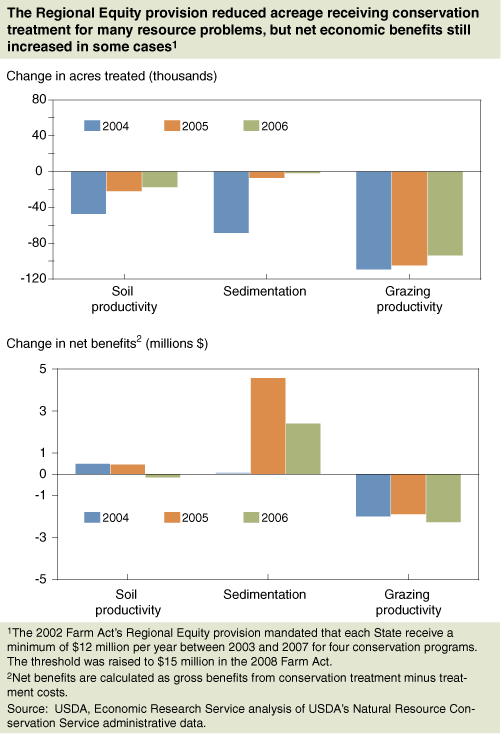Farm Act’s Regional Equity Provision May Entail Conservation Tradeoffs
- by Cynthia Nickerson
- 12/1/2010
Many Federal conservation programs allocate program funds to State offices, which then enroll program participants. Doing so ensures that all parts of the country benefit and allows States to fund conservation practices that best meet local needs.
The 2002 Farm Act’s Regional Equity provision reinforced this allocation goal by mandating that each State receive a minimum of $12 million per year between 2003 and 2007 for four conservation programs. The threshold was raised to $15 million in the 2008 Farm Act. Since the program budgets were not augmented to cover the minimum allocation requirement, the provision shifted funding from States that exceeded the threshold to those previously below it and changed the number of producers each State could enroll.
Redirecting funds can work at cross purposes to the programs’ environmental and economic goals of helping farmers adopt cost-effective conservation practices. If the additional producers enrolled in States previously below the threshold treat different environmental problems or receive different levels of support than producers they replace in States losing funds, the programs’ ability to address conservation needs cost effectively may be affected in complex ways.
Analysis of 2004-06 data (when the 2002 Farm Act was in effect) from USDA’s Environmental Quality Incentives Program (EQIP)—the largest program covered by the Regional Equity provision—reveals that the funding shifts reduced the number of acres receiving treatment for many resource problems. However, this redirection of funds did not always result in a decline in net economic benefits because changes in physical measures (such as acres receiving conservation treatment) are not always correlated with the economic benefits provided by these conservation treatments. For instance, in EQIP, even though cross-State enrollments shifted and the acreage treated for soil productivity and other erosion problems declined as a result, in some years, net economic benefits from improved soil productivity and reduced sedimentation increased. Net benefits increased when producers in States that received increased funding undertook more cost-effective conservation actions that benefited more people than did producers in the other States.
This article is drawn from:
- Nickerson, C., Ribaudo, M. & Higgins, N. (2010). The Farm Act's Regional Equity Provision: Impacts on Conservation Program Outcomes. U.S. Department of Agriculture, Economic Research Service. ERR-98.


